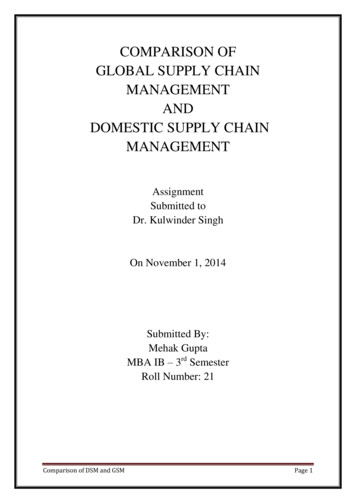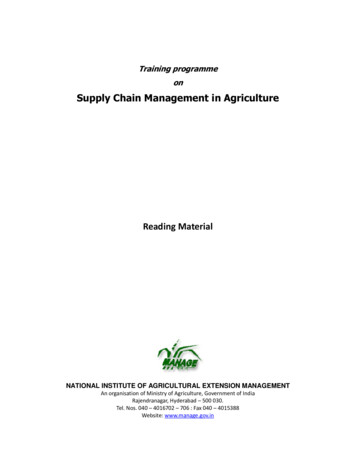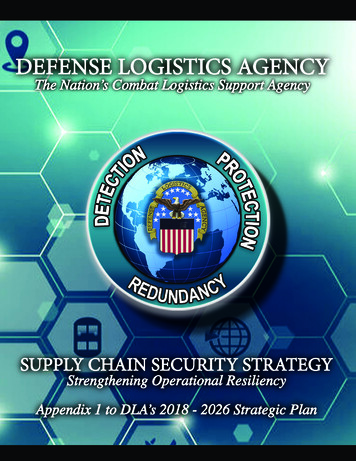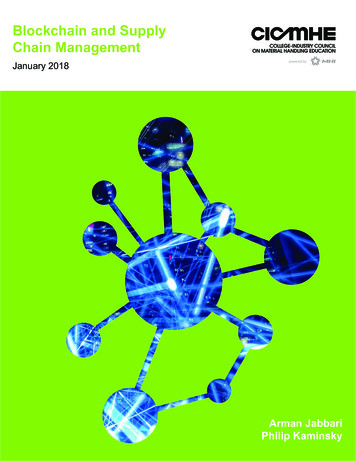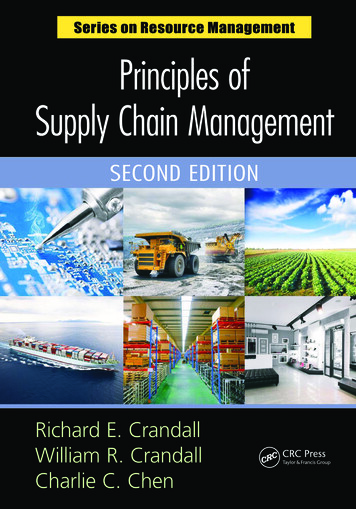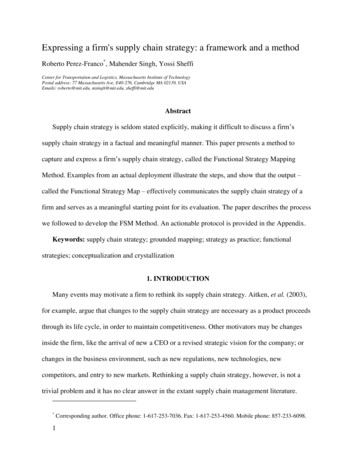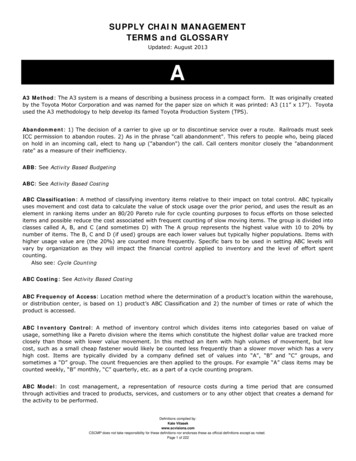
Transcription
SUPPLY CHAIN MANAGEMENTTERMS and GLOSSARYUpdated: August 2013AA3 Method: The A3 system is a means of describing a business process in a compact form. It was originally createdby the Toyota Motor Corporation and was named for the paper size on which it was printed: A3 (11” x 17”). Toyotaused the A3 methodology to help develop its famed Toyota Production System (TPS).Abandonment: 1) The decision of a carrier to give up or to discontinue service over a route. Railroads must seekICC permission to abandon routes. 2) As in the phrase "call abandonment". This refers to people who, being placedon hold in an incoming call, elect to hang up ("abandon") the call. Call centers monitor closely the "abandonmentrate" as a measure of their inefficiency.ABB: See Activity Based BudgetingABC: See Activity Based CostingABC Classification: A method of classifying inventory items relative to their impact on total control. ABC typicallyuses movement and cost data to calculate the value of stock usage over the prior period, and uses the result as anelement in ranking items under an 80/20 Pareto rule for cycle counting purposes to focus efforts on those selecteditems and possible reduce the cost associated with frequent counting of slow moving items. The group is divided intoclasses called A, B, and C (and sometimes D) with The A group represents the highest value with 10 to 20% bynumber of items. The B, C and D (if used) groups are each lower values but typically higher populations. Items withhigher usage value are (the 20%) are counted more frequently. Specific bars to be used in setting ABC levels willvary by organization as they will impact the financial control applied to inventory and the level of effort spentcounting.Also see: Cycle CountingABC Costing: See Activity Based CostingABC Frequency of Access: Location method where the determination of a product’s location within the warehouse,or distribution center, is based on 1) product’s ABC Classification and 2) the number of times or rate of which theproduct is accessed.ABC Inventory Control: A method of inventory control which divides items into categories based on value ofusage, something like a Pareto division where the items which constitute the highest dollar value are tracked moreclosely than those with lower value movement. In this method an item with high volumes of movement, but lowcost, such as a small cheap fastener would likely be counted less frequently than a slower mover which has a veryhigh cost. Items are typically divided by a company defined set of values into “A”, “B” and “C” groups, andsometimes a “D” group. The count frequencies are then applied to the groups. For example “A” class items may becounted weekly, “B” monthly, “C” quarterly, etc. as a part of a cycle counting program.ABC Model: In cost management, a representation of resource costs during a time period that are consumedthrough activities and traced to products, services, and customers or to any other object that creates a demand forthe activity to be performed.Definitions compiled by:Kate Vitasekwww.scvisions.comCSCMP does not take responsibility for these definitions nor endorses these as official definitions except as noted.Page 1 of 222
SUPPLY CHAIN MANAGEMENTTERMS and GLOSSARYUpdated: August 2013ABC System: In cost management, a system that maintains financial and operating data on an organization'sresources, activities, drivers, objects and measures. ABC models are created and maintained within this system.ABI: See Automated Broker InterfaceABM: See Activity Based ManagementAbnormal Demand: Demand for a product which is either greater or lower than expected by a given percentagewhich is determined by the organization. When observed, it should be determined whether it may be a one-timespike, or if the effect is part of a trend which should be considered during future forecasts.ABP: See Activity Based PlanningAbsorption Costing: A cost accounting approach which captures overhead and other indirect costs as separate fromunit costs for a given period, and then applies (absorbs) those costs into unit costs at the period end based onvarious factors such as movement and COGS elements.ACAT: See Acquisition CategoriesAcceptable Quality Level (AQL): In quality assessment, acceptable quality level, also known as assured qualitylevel, describes the maximum number of defects acceptable during the random sampling of an inspection.Acceptable Sampling Plan: A quality management procedure which defines the sample sizes and acceptable defectlevels for validating quality of products.Acceptance Number: See Acceptable Quality LevelAcceptance Sampling: A statistical quality control method which tests samples of products at defined points asopposed to testing each product.Accessibility: The ability of a carrier to provide service between an origin and a destination.Accessorial Charges: A carrier's charge for accessorial services such as loading, unloading, pickup, and delivery.Also see: UpchargesAccessorial Fee: See Accessorial ChargesAccessory: A choice or feature added to the good or service offered to the customer for customizing the endproduct. An accessory enhances the capabilities of the product but is not necessary for the basic function of theproduct. In many companies, an accessory means that the choice does not have to be specified before shipment butcan be added at a later date. In other companies, this choice must be made before shipment.Definitions compiled by:Kate Vitasekwww.scvisions.comCSCMP does not take responsibility for these definitions nor endorses these as official definitions except as noted.Page 2 of 222
SUPPLY CHAIN MANAGEMENTTERMS and GLOSSARYUpdated: August 2013Accountability: The act of making a group or individual responsible for certain activities or outcomes. For example,managers and executives are accountable for business performance even though they may not actually perform thework.Accounts Payable (A/P): 1) a financial term referring to the amount of transactions which have been accrued butnot paid to a vendor. 2) An accounting functionAccounts Receivable (A/R): On a company's balance sheet, accounts receivable is the amount that customersowe to that company. Sometimes called trade receivables, they are classified as current assets assuming that theyare due within one year.Accreditation: The process in which certification of competency, authority, or credibility is presented. An exampleof accreditation is the accreditation of testing laboratories and certification specialists that are permitted to issueofficial certificates of compliance with established standards.Accredited Standards Committee (ASC): A committee of the ANSI chartered in 1979 to develop uniformstandards for the electronic interchange of business documents. The committee develops and maintains U.S. genericstandards (X12) for Electronic Data Interchange.Accumulation bin: An area where item to be used in assembly of a product are staged prior to work being done.Also see: StagingAccuracy: A value, usually expressed as a percentage, which expresses the level of precision incurred duringtransactions. An example would be seen when comparing actual inventory levels to what was expected frombookkeeping records.ACD: See Automated Call DistributionACE: See Automated Commercial EnvironmentACH: See Automated ClearinghouseAcknowledgment: Typically this is a response, either electronic or as a physical document, which confirms thereceipt of an order from the supplier to the buyer.Acquisition Categories (ACAT): U.S. DoD ACAT 1 programs are Milestone Decision Authority Programs orprograms designated ACAT 1 by the Milestone Decision Authority.Acquisition Cost: The net price plus other costs needed to purchase the item and get it to the point of use. Theseother costs can include: the item's purchasing costs (closing, research, accounting, commissions and legal fees),transportation, preparation and installation costs.Definitions compiled by:Kate Vitasekwww.scvisions.comCSCMP does not take responsibility for these definitions nor endorses these as official definitions except as noted.Page 3 of 222
SUPPLY CHAIN MANAGEMENTTERMS and GLOSSARYUpdated: August 2013ACSI: See American Customer Satisfaction IndexAction Message: A system message usually created during MRP calculations to call attention to a current orpotential problem and suggest corrective action.Action Plan: A specific method or process to achieve the results called for by one or more objectives. An actionplan may be a simpler version of a project plan.Action Report: See Action MessageActivation: TOC recognizes that it is possible to produce without contributing to throughput. TOC defines productionthat contributes to throughput as utilization. Production that does not contribute to throughput is known asactivation. Activation is not desired because it not only fails to increase throughput, but it also increases inventoryand operating expense. This is consistent with the Just-In-Time (JIT) philosophy.Active Inventory: Materials held in a facility which are intended to be consumed in manufacturing / assembly, orsold in a specified period.Active Stock: Goods in active pick locations and ready for order filling.Activity: Work performed by people, equipment, technologies or facilities. Activities are usually described by the“action-verb-adjective-noun” grammar convention. Activities may occur in a linked sequence and activity-to-activityassignments may exist.Activity Analysis: The process of identifying and cataloging activities for detailed understanding and documentationof their characteristics. An activity analysis is accomplished by means of interviews, group sessions, questionnaires,observations, and reviews of physical records of work.Activity Based Budgeting (ABB): An approach to budgeting where a company uses an understanding of itsactivities and driver relationships to quantitatively estimate workload and resource requirements as part of anongoing business plan. Budgets show the types, number of and cost of resources that activities are expected toconsume based on forecasted workloads. The budget is part of an organization’s activity-based planning process andcan be used in evaluating its success in setting and pursuing strategic goals.Activity Based Costing (ABC): A methodology that measures the cost and performance of cost objects, activitiesand resources. Cost objects consume activities and activities consume resources. Resource costs are assigned toactivities based on their use of those resources, and activity costs are reassigned to cost objects (outputs) based onthe cost objects proportional use of those activities. Activity-based costing incorporates causal relationships betweencost objects and activities and between activities and resources.Definitions compiled by:Kate Vitasekwww.scvisions.comCSCMP does not take responsibility for these definitions nor endorses these as official definitions except as noted.Page 4 of 222
SUPPLY CHAIN MANAGEMENTTERMS and GLOSSARYUpdated: August 2013Activity-Based Management (ABM): A discipline focusing on the management of activities within businessprocesses as the route to continuously improve both the value received by customers and the profit earned inproviding that value. ABM uses activity-based cost information and performance measurements to influencemanagement action.See also: Activity-Based CostingActivity Based Planning (ABP): Activity-based planning (ABP) is an ongoing process to determine activity andresource requirements (both financial and operational) based on the ongoing demand of products or services byspecific customer needs. Resource requirements are compared to resources available and capacity issues areidentified and managed. Activity-based budgeting (ABB) is based on the outputs of activity-based planning.Activity Dictionary: A listing and description of activities that provides a common/standard definition of activitiesacross the organization. An activity dictionary can include information about an activity and/or its relationships, suchas activity description, business process, function source, whether value-added, inputs, outputs, supplier, customer,output measures, cost drivers, attributes, tasks, and other information as desired to describe the activity.Activity Driver: The best single quantitative measure of the frequency and intensity of the demands placed on anactivity by cost objects or other activities. It is used to assign activity costs to cost objects or to other activities.Activity Level: A description of types of activities dependent on the functional area. Product-related activity levelsmay include unit, batch, and product levels. Customer-related activity levels may include customer, market,channel, and project levels.Activity Network Diagram: An arrow diagram used in planning and managing processes and projects.Actual Cost System: A managerial accounting system that records and measures all cost elements at their actualacquisition value. Indirect costs are then applied as overhead using a cost allocation technique.Actual Costs: The actual labor, material, and allocated overhead costs incurred in the acquisition or production of aproduct.Actual Demand: The known demand for a specific product based on customer orders and production orders whichare open. Once an order is shipped or production is completed, specific demand quantity will become usage. Actualdemand should be netted against any forecast for the same period, meaning that as orders are received they areconsidered to be part of an earlier forecast and forecasts should be considered as satisfied.Actual to Target Gap Analysis: See Gap AnalysisActual to Theoretical Cycle Time: The ratio of the measured time required to produce a given output divided bythe sum of the time required to produce a given output based on the rated efficiency of the machinery and laboroperations.Definitions compiled by:Kate Vitasekwww.scvisions.comCSCMP does not take responsibility for these definitions nor endorses these as official definitions except as noted.Page 5 of 222
SUPPLY CHAIN MANAGEMENTTERMS and GLOSSARYUpdated: August 2013Adaptive Smoothing: A special type of exponential smoothing that takes the success of previous forecasts intoaccount when setting a value of ALPHA for the next period. In this manner, periods that experienced high error willcause ALPHA to be set high and, thus, adjust quickly. When error is low, AS assumes the technique is doing well andsets ALPHA at a low level. This makes ES much more responsive to changes in the level of the data and less reactiveto noise. The advantage to adaptive smoothing is that the decision of what value of ALPHA to use in exponentialsmoothing is eliminated. A disadvantage to adaptive smoothing is that trend and seasonality are ignored.ADR: See Alternate Dispatch ResolutionAdvance Material Request: A request for materials which is created in advance of formal need due to long leadtimes for components, etc.Advanced Planning and Scheduling (APS): Refers to a manufacturing management process by which rawmaterials and production capacity are optimally allocated to meet demand. APS is especially well-suited toenvironments where simpler planning methods cannot adequately address complex trade-offs between competingpriorities.Advanced Shipping Notice (ASN): Detailed shipment information transmitted by the shipper to a customer orconsignee in advance of delivery, designating the contents (individual products and quantities of each) and nature ofthe shipment. In EDI data standards this is referred to as an 856 transaction. May also include carrier and shipmentspecifics including time of shipment and expected time of arrival. The ASN data can be valuable in providing digitalknowledge about what is in a shipment in a way that it can be used to eliminate manual data entry of eachshipment.Aftermarket: A market for parts and accessories used in the repair or enhancement of a product. A secondarymarket created after the original market sales are finished.After-Sale Service: Services provided to the customer after products have been delivered. This can includerepairs, maintenance and/or telephone support.Synonym: Field ServiceAgency tariff: A publication of a rate bureau that contains rates for many carriers.Agent: An enterprise authorized to transact business for, or in the name of, another enterprise.Agglomeration: A net advantage gained by a common location with other companies.Aggregate Forecast: Forecasting of future demand for a family of products or for a single product across multipledimensions of source - including planned production and customer orders.Aggregate Inventory: The total inventory available for any given product across multiple locations and/or multiplestock-keeping units.Definitions compiled by:Kate Vitasekwww.scvisions.comCSCMP does not take responsibility for these definitions nor endorses these as official definitions except as noted.Page 6 of 222
SUPPLY CHAIN MANAGEMENTTERMS and GLOSSARYUpdated: August 2013Aggregate Inventory Management: A method of managing inventory through the use of levels set against overallinventory or class value.Aggregate Picking: A method common to operations which deliver via a direct to store route driver. In thissituation the driver or picker will pull the aggregate number of products anticipated to be needed for a delivery run,and create crates or pallets of the same SKU, which the driver will pull from as needed for each stop on the route.Aggregate Plan: A plan for the production process, 2 to 18 months in advance to give management an idea to ofwhat quantity of materials and other resources are to be procured and when, so that the total cost of operations ofthe organization is kept to the minimum over that period.Aggregate Planning: An operational activity which compiles an aggregate plan for the production process.Aggregate Tender Rate: A reduced rate offered to a shipper who tenders two or more class-rated shipments atone time and one place.Agile Manufacturing: Tools, techniques, and initiatives that enable a plant or company to thrive under conditionsof unpredictable change. Agile manufacturing not only enables a plant to achieve rapid response to customer needs,but also includes the ability to quickly reconfigure operations-and strategic alliances-to respond rapidly to unforeseenshifts in the marketplace. In some instances, it also incorporates "mass customization" concepts to satisfy uniquecustomer requirements. In broad terms, it includes the ability to react quickly to technical or environmentalsurprises.Agility: The ability to rapidly and cost effectively adapt to market changes with no significant negative impact onquality or dependability.AGVS: See Automated Guided Vehicle SystemAir Cargo: Refers to freight that is moved via air transportation.Air Cargo Containers: Containers designed to conform to the inside of an aircraft. There are many shapes andsizes of containers. Air cargo containers fall into three categories: 1) air cargo pallets 2) lower deck containers 3)box type containers.Air Force Material Command: See AMFCAir Mobility Command: See AMCAir Taxi: An exempt for-hire air carrier that will fly anywhere on demand: air taxis are restricted to a maximumpayload and passenger capacity per plane.Air Transport Association of America: A U.S. airline industry association.Definitions compiled by:Kate Vitasekwww.scvisions.comCSCMP does not take responsibility for these definitions nor endorses these as official definitions except as noted.Page 7 of 222
SUPPLY CHAIN MANAGEMENTTERMS and GLOSSARYUpdated: August 2013Air Waybill (AWB): A bill of lading for air transport that serves as a receipt for the shipper indicates that the carrierhas accepted the goods listed. Acceptance obligates the carrier to carry the consignment to the airport of destinationaccording to specified conditions.Airport and Airway Trust Fund: A federal fund that collects passenger ticket taxes and disburses those funds forairport facilities.Alaskan Carrier: A for-hire air carrier that operates within the state of Alaska.Alert: See Action MessageAlgorithm: A clearly specified mathematical process for computation; a set of rules, which, if followed, give aprescribed result.All-cargo carrier: An air carrier that transports cargo only.Allocated Item: A feature of an inventory control and order management system which allows for quantitiesavailable in inventory to be associated with a customer or production order so that the quantity cannot otherwise beused.Allocation: 1) In cost accounting, a distribution of costs using calculations that may be unrelated to physicalobservations or direct or repeatable cause-and-effect relationships. Because of the arbitrary nature of allocations,costs based on cost causal assignment are viewed as more relevant for management decision-making. 2) In ordermanagement, allocation of available or incoming inventory to customer and production orders.Allocation Costing: A method of allocating indirect / overhead costs to inventory items and costs of sales.See also: Absorption CostingAlpha Release: A very early release of a product to get preliminary feedback about the feature set and usability.Alternate Dispute Resolution (ADR): Any of a number of methods (such as mediation, arbitration, mock trials,etc) used to resolve disputes outside of litigation.Alternate Routing: In a production environment this is an optional process for manufacturing or assembly of aproduct, which may be employed due to unavailability of a primary work center, or choice of non-standardcomponents. May also refer to a transportation route which is different than what would normally be taken, perhapsdue to weather.American Customer Satisfaction Index (ACSI): Released for the first time in October 1994, an economicindicator and cross industry measure of the satisfaction of U.S. household customers with the quality of the goodsand services available to them-both those goods and services produced within the United States and those providedas imports from foreign firms that have substantial market shares or dollar sales. The ACSI is co-sponsored by theUniversity of Michigan Business School, ASQ and the CFI Group.Definitions compiled by:Kate Vitasekwww.scvisions.comCSCMP does not take responsibility for these definitions nor endorses these as official definitions except as noted.Page 8 of 222
SUPPLY CHAIN MANAGEMENTTERMS and GLOSSARYUpdated: August 2013American National Standards Institute (ANSI): A non-profit organization chartered to develop, maintain, andpromulgate voluntary U.S. national standards in a number of areas, especially with regards to setting EDI standards.ANSI is the U.S. representative to the International Standards Organization (ISO).American Society for Quality (ASQ): A professional organization with more than 100,000 members whichadvances learning, quality improvement, and knowledge exchange to improve business results, and to create betterworkplaces and communities worldwide.American Society for Testing and Materials (ASTM): Not-for-profit organization that provides a forum for thedevelopment and publication of voluntary consensus standards for materials, products, systems and services.American Society for Training and Development (ASTD): A membership organization providing materials,education and support related to workplace learning and performance.American Society of Transportation & Logistics: A professional organization in the field of logistics.American Standard Code for Information Interchange (ASCII): ASCII format - simple text based data with noformatting. ASCII is the standard code for information exchange among data processing systems. Uses a codedcharacter set consisting of 7-bit coded characters (8 bits including parity check).American Trucking Association, Inc. (ATA): A motor carrier industry association that is made up of subconferences representing various sectors of the motor carrier industry.American Waterway Operators: A domestic water carrier industry association representing barge operators onthe inland waterways.AMC: The US Air Force Air Mobility Command's mission is to provide global air mobility. The command also plays acrucial role in providing humanitarian support at home and around the world. AMC Airmen--active duty, Air NationalGuard, Air Force Reserve and Civil Reserve Air Fleet.AMFC: Air Force Material Command conducts research, development, testing and evaluation, and provides theacquisition management services and logistics support necessary to keep Air Force weapon systems ready for war.The command develops, acquires and sustains the aerospace power needed to defend the United States and itsinterests for today and tomorrow.AMS: See Automated Manifest SystemAmtrak: The National Railroad Passenger Corporation, a federally created corporation that operates most of theUnited States' intercity passenger rail service.Analysis of Variance (ANOVA): A statistical term that refers to a collection of statistical models which test themeans of several groups to determine if the means are equal.Definitions compiled by:Kate Vitasekwww.scvisions.comCSCMP does not take responsibility for these definitions nor endorses these as official definitions except as noted.Page 9 of 222
SUPPLY CHAIN MANAGEMENTTERMS and GLOSSARYUpdated: August 2013Andon: A manufacturing term referring to a signboard incorporating signal lights, audio alarms, and text or otherdisplays installed at a workstation to notify management and other workers of a quality or process problem.Animated GIF: A file that contains a series of GIF (Graphics Interchange Format) images that are displayed in rapidsequence by some Web browsers, giving an animated effect.See also: GIFANOVA: See Analysis of VarianceANSI: See American National Standards InstituteANSI ASC X12: American National Standards Institute Accredited Standards Committee X12. The X12 committee ofANSI is charged with setting EDI standards.ANSI Standard: A published transaction set approved by ANSI. The standards are reviewed every six months.Anticipated Delay Report: A report, normally handwritten, which is created by the procurement and productionareas to advise management regarding orders which are not expected to be completed on time.Anticipation Inventories: Extra stocks of inventory which are being held above known requirement in order toaccommodate trends or promotions. May also be used to hedge against risk of supply problems.Anticipation Order: An order placed in advance of the availability of a product for delivery at a future date.Anticipation orders are frequently used in the retail environment where suppliers are previewing new products attrade shows and want to get a commitment from their retail customers prior to production of seasonal items.Anti-Deficiency Act [Title 31, U.S. Code, Sec1341 & 1517]: Prohibits making or authorizing an obligation inexcess of the amount available; forbids obligation to pay money from the US Treasury in advance of theappropriation; requires agency to fix responsibility for violations of the Act.Anti-Dumping Duty: An additional import duty imposed in instances where imported goods are priced at less thanthe normal price charged in the exporter's domestic market and cause material injury to domestic industry in theimporting country.Any-quantity Rate (AQ): The same rate applies to any size shipment tendered to a carrier; no discount rate isavailable for large shipments.A/P: See Accounts PayableDefinitions compiled by:Kate Vitasekwww.scvisions.comCSCMP does not take responsibility for these definitions nor endorses these as official definitions except as noted.Page 10 of 222
SUPPLY CHAIN MANAGEMENTTERMS and GLOSSARYUpdated: August 2013Applicability Statement 2 (AS2): A specification for Electronic Data Interchange between businesses using theInternet's Web page protocol, the Hypertext Transfer Protocol (HTTP). The specification is an extension of the earlierversion, Applicability Statement 1 (AS1). Both specifications were created by EDI over the Internet (EDIINT), aworking group of the Internet Engineering Task Force (IETF) that develops secure and reliable businesscommunications standards.Application Service Provider (ASP): A company that offers access over the Internet to application (examples ofapplications include word processors, database programs, Web browsers, development tools, communicationprograms) and related services that would otherwise have to be located in their own computers. Sometimes referredto as "apps-on-tap", ASP services are expected to become an important alternative, especially for smaller companieswith low budgets for information technology. The purpose is to try to reduce a company's burden by installing,managing, and maintaining software.Application-to-Application: The direct interchange of data between computers, without re-keying.Appointment Freight: Shipments which are held at the carrier’s terminal to be delivered at a specific date andtime. Typically this occurs when a shipment is received by the carrier facility 1 or more days prior to the agreed upondelivery schedule. The shipment cannot immediately be delivered and must be held at the facility.Approved Vendor List (AVL): List of the suppliers approved for doing business. The AVL is usually created byprocurement or sourcing and engineering personnel using a variety of criteria such as technology, functional fit ofthe product, financial stability, and past performance of the supplier.APS: See Advanced Planning and SchedulingAQ: See Any quantity rateAQL: See Acceptable Quality LevelA/R: See Accounts ReceivableArmy Corps of Engineers: A US federal agency responsible for the construction and maintenance or waterways.Arrival Notice: A notice from the delivering carrier to the Notify Party indicating the shipment's arrival date at aspecific location (normally the destination).Arrow Dia
Updated: August 2013 TERMS and GLOSSARY SUPPLY CHAIN MANAGEMENT ACAT: See Acquisition Categories Also see: Upcharges Acceptable Sampling Plan: A quality management procedure which defines the sample sizes and acceptable defect levels for validating quality of products. Acceptable Quality Level (AQL): In quality assessment, acceptable quality level, also known as assured quality

